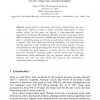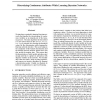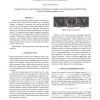FUZZIEEE
2007
IEEE
15 years 1 months ago
2007
IEEE
— This paper provides a broad overview of logical and black box approaches to fuzzy and rough hybridization. The logical approaches include theoretical, supervised learning, feat...
ICPR
2008
IEEE
15 years 2 months ago
2008
IEEE
We present a video summarization technique based on supervised learning. Within a class of videos of similar nature, user provides the desired summaries for a subset of videos. Ba...
DIS
2009
Springer
15 years 2 months ago
2009
Springer
Multiple-instance learning (MIL) is a generalization of the supervised learning problem where each training observation is a labeled bag of unlabeled instances. Several supervised ...
ATAL
2009
Springer
15 years 2 months ago
2009
Springer
Improving the sample efficiency of reinforcement learning algorithms to scale up to larger and more realistic domains is a current research challenge in machine learning. Model-ba...
ADMA
2009
Springer
15 years 2 months ago
2009
Springer
Image spam is a new trend in the family of email spams. The new image spams employ a variety of image processing technologies to create random noises. In this paper, we propose a s...
ICML
1996
IEEE
15 years 8 months ago
1996
IEEE
We introduce a method for learning Bayesian networks that handles the discretization of continuous variables as an integral part of the learning process. The main ingredient in th...
ICML
2008
IEEE
15 years 8 months ago
2008
IEEE
In this paper we perform an empirical evaluation of supervised learning on highdimensional data. We evaluate performance on three metrics: accuracy, AUC, and squared loss and stud...
ICML
2008
IEEE
15 years 8 months ago
2008
IEEE
We introduce a boosting framework to solve a classification problem with added manifold and ambient regularization costs. It allows for a natural extension of boosting into both s...
ICML
2009
IEEE
15 years 8 months ago
2009
IEEE
Training principles for unsupervised learning are often derived from motivations that appear to be independent of supervised learning. In this paper we present a simple unificatio...
ICIP
2007
IEEE
15 years 9 months ago
2007
IEEE
Different from appearance-based methods, clustering feature points only by their motion coherence is an emerging category of approach to detecting and tracking individuals among c...





